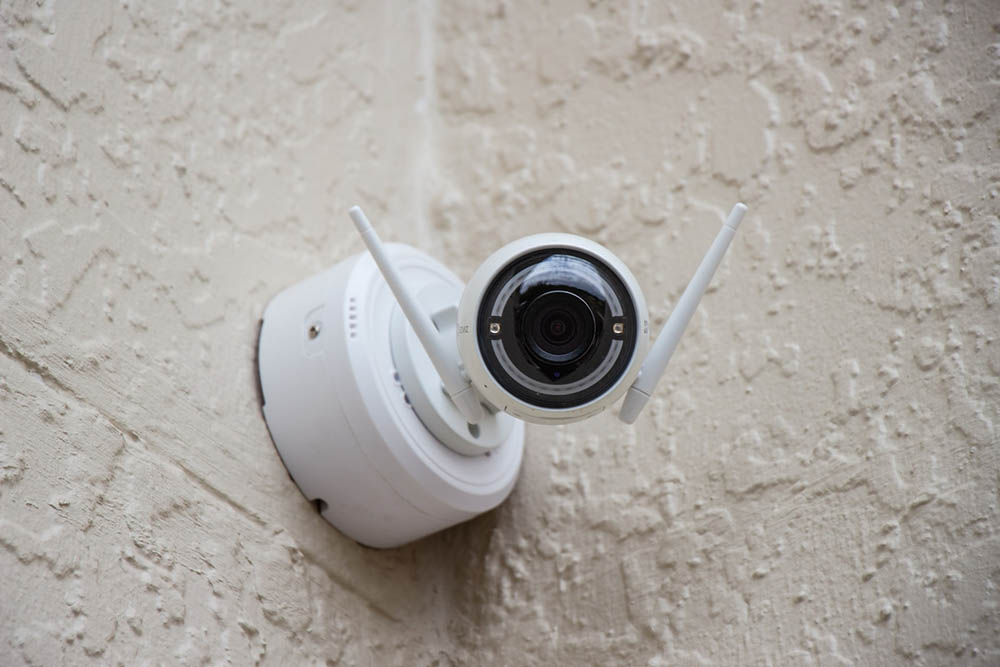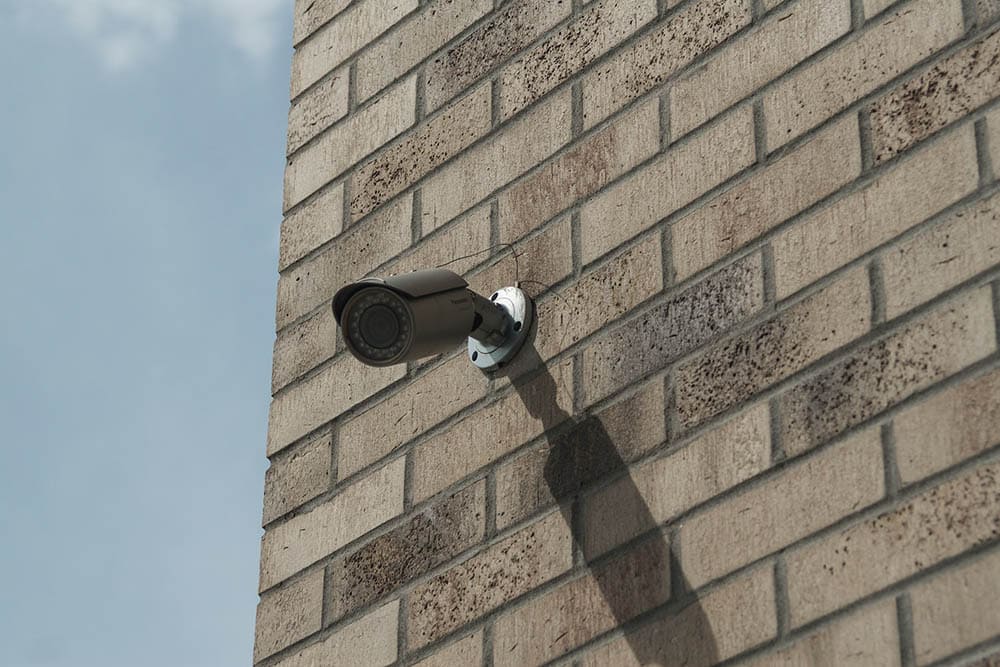What Are CCTV Cameras? Pros, Cons, Uses, & Types
Last Updated on

Most people have probably been unwittingly caught on CCTV more than once in their lives. In fact, research shows¹ that the average American is caught on CCTV 238 times per week. But what are CCTV cameras, and how do they work?
CCTV stands for Closed Circuit Television, but you may have heard people refer to it as surveillance cameras, too. Most CCTV systems consist of one or more strategically placed cameras that transmit live footage to one or more monitors. The footage is also recorded and stored, either locally or on the cloud, for playback.
Aside from everyday surveillance and the deterrence of criminals, CCTV can also be used to notify the owners of the premises when there is activity at times when there shouldn’t be—e.g., when it’s closed for the holidays.

How Does It Work?
A CCTV system can be as simple as a wire-free camera connected to your smartphone, or it can be as complex as many cameras, connected to various monitors across several buildings. Regardless of the size or type of CCTV, they all work in a similar way.
Cameras, which are strategically placed, capture live footage of a particular area. The footage is then transmitted to a recording device (DVR or NVR), and a monitor, smartphone, or computer. While the footage is shown in real time on the monitor, the recording device stores the video for later reference. Some modern CCTV systems may not have a local recording device—instead, the footage may be stored in the cloud.

Analog CCTV
These traditional CCTV cameras are connected to a power source, and a recording device, or CCTV system, via a coaxial cable. The cameras themselves do not store anything internally. The footage is captured in an analog format, and transmitted directly to the DVR system for processing.
Analog cameras are more difficult and more expensive to set up because of the amount of cabling that needs to be put in place. Additionally, analog cameras usually capture footage that is lower in quality than most IP cameras. Their frame rate is also slower, which means they’re not great for areas where there is a lot of traffic or movement.
The benefit of an analog system is that it isn’t dependent on an internet connection. Even if you have an unreliable internet connection, your CCTV system will carry on working.
IP Surveillance Cameras
Internet Protocol surveillance cameras are often referred to as CCTV cameras too, even though the term Closed Circuit Television only applies to analog systems where the camera transmits data to a DVR via a wired connection.
With IP surveillance cameras, there’s no need for coaxial cables. These cameras stream live footage—either over the internet, or a local area network. These cameras can connect either via a Power over Ethernet (PoE) cable, or even over WiFi.
Even when using WiFi, most of these cameras will still need to be connected to a power source, so they are not wire-free. Some IP cameras come with rechargeable batteries, making them wire-free.
IP Cameras are usually easier, cheaper, and quicker to set up. They offer better quality footage, and most modern cameras will stream live footage to your smartphone. Cloud-based CCTV systems will store your footage in the cloud, so there’s no need to worry about how you will store any data locally.
That said, for facilities, businesses, or homes that do not have a reliable internet connection, traditional CCTV systems may suit them better.

What Are the Different Types of CCTV Cameras?
One of the most important components of a CCTV system is the camera itself. When it comes to security cameras, there are different types to suit each environment. For example, you wouldn’t want to use an indoor camera outdoors, or vice versa.

Outdoor
There are various types of outdoor cameras, and they’re all built using strong, weatherproof materials. Rain, hail, snow, and heat will not affect the performance of these CCTV cameras. Outdoor CCTV cameras can usually adjust to different lighting conditions, and most are equipped with motion sensors.
Indoor
Indoor CCTV is installed in a variety of settings—from office buildings and shopping malls, to banks and secure facilities. The main difference between indoor and outdoor cameras is that indoor cameras are not built to withstand the elements, which makes them smaller, and more lightweight. Indoor cameras are often lower in price than outdoor cameras.
Bullet
Bullet cameras are the most commonly used outdoor CCTV cameras. They are large and noticeable, and can often be spotted on the external corners of large buildings and facilities pointing towards car parks, entries, and exits. These cameras are great for long-distance, and night-time viewing.
Dome
Dome CCTV cameras are versatile and sleek. They’re often used in banks, casinos, and hotels, where they are discretely positioned on ceilings and walls. As their name suggests, they have a clear dome encasing to protect them from vandalism, and the elements.

Pan-tilt-zoom (PTZ)
Pan-tilt-zoom cameras are dome-shaped cameras too, but they can be remotely controlled. The person in charge of security can remotely angle the camera in any direction, and zoom into a particular spot to reveal details, such as facial features or license plates.
Turret
While very similar to dome-shaped cameras, turret CCTV cameras lack the external protective glass encasing that dome cameras have. While the glass dome does protect the camera against vandals, there’s a reason some people go for turret cameras instead. Turret CCTV cameras are known for capturing crisp and clear images, whereas the glass encasing on dome cameras can cause glare, and even obscure the footage if it’s dirty.

Where is It Used?

CCTV cameras are used in a wide variety of settings, for a wide range of purposes.
1. Traffic Monitoring
Often strategically placed on highways, intersections, and high-traffic areas, CCTV cameras are used by law enforcement officers to monitor traffic, and to watch out for those driving in a way that may endanger others.
2. Public Transport
CCTV cameras are now installed at most bus and subway stations. They’re used to monitor unusual or suspicious behavior, and to identify criminals. If there was an emergency, rescue and emergency workers could use CCTV footage to assess the situation before entering the building.
3. Airports
There are CCTV cameras strategically installed throughout airports. Usually, they cover every entry and exit in order to capture everyone who comes into the airport. CCTV cameras are also used to monitor confrontations and suspicious behavior.
4. Businesses
Banks, museums, hotels, restaurants, and stores have CCTV cameras to monitor the activities of not only their visitors, but also potentially their workers. The CCTV cameras are there to deter crime, but in the event that a crime does happen, the footage can be used to aid an investigation, as well as provide evidence.
5. Home Security
CCTV cameras are easier to purchase and set up now than they ever have been. Affordable cameras can be ordered online and set up wirelessly with minimal technical know-how. Many people now choose to have CCTV set up so that they can monitor their homes while they are at work, or away for long periods. Not only does CCTV offer peace of mind, but it can also be used to identify criminals if the worst was to ever happen.
Advantages of CCTV Cameras

- Modern CCTV systems are becoming increasingly easy to set up.
- With so many options, CCTV is affordable to most people, and businesses.
- Modern CCTV cameras with motion sensors can notify you of unexpected visitors.
- Real-time footage of your home or business can give you peace of mind.
- CCTV cameras can deter criminals.
- If a crime takes place, CCTV can provide valuable insights and evidence.
Disadvantages of CCTV Cameras
The main disadvantage of CCTV cameras is that they can cause people to be concerned about privacy. At the start of this article, we mentioned that according to a study¹, an average American is captured on CCTV 238 times per week—a number that’s likely to cause at least a slight level of discomfort to some people.
Most customers and employees may dislike the notion of being filmed constantly. It can cause employees to feel as though they are not trusted and, therefore, not valued.
Finally, while it may deter criminals, CCTV cameras on their own do not stop a crime from happening. Additionally, as advanced and robust as modern security cameras are, they are not indestructible, and seasoned criminals may be able to damage them to obscure evidence.

Final Thoughts
CCTV cameras are used for surveillance around the world, and they’re only becoming more popular as technology advances. There is a wide array of CCTV cameras available, but they all work similarly. CCTV cameras capture footage that is either streamed to a device, such as a smartphone, or transmitted to a recording device (DVR) and a monitor.
Surveillance systems are used to monitor businesses, offices, homes, research facilities, hospitals, and many other settings. On roads and highways, CCTV is used by law enforcement officers to monitor drivers, and to stop those who may be endangering others.
Featured Image Credit: Alan J. Hendry, Unsplash
About the Author Cheryl Regan
Cheryl is a freelance content and copywriter from the United Kingdom. Her interests include hiking and amateur astronomy but focuses her writing on gardening and photography. If she isn't writing she can be found curled up with a coffee and her pet cat.
Related Articles:
Binocular Magnification Chart: Numbers & Distances Compared
How to Clean a Refractor Telescope: Step-by-Step Guide
How to Clean a Telescope Eyepiece: Step-by-Step Guide
How to Clean a Rifle Scope: 8 Expert Tips
Monocular vs Telescope: Differences Explained (With Pictures)
What Is a Monocular Used For? 8 Common Functions
How to Clean a Telescope Mirror: 8 Expert Tips
Brightfield vs Phase Contrast Microscopy: The Differences Explained
